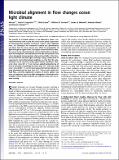Microbial alignment in flow changes ocean light climate
Author(s)
Marcos; Seymour, Justin R.; Luhar, Mitul; Durham, William M.; Mitchell, James G.; Mackee, Andreas; Stocker, Roman; ... Show more Show less
DownloadStocker_Microbial alignment.pdf (402.7Kb)
PUBLISHER_POLICY
Publisher Policy
Article is made available in accordance with the publisher's policy and may be subject to US copyright law. Please refer to the publisher's site for terms of use.
Terms of use
Metadata
Show full item recordAbstract
The growth of microbial cultures in the laboratory often is assessed informally with a quick flick of the wrist: dense suspensions of microorganisms produce translucent “swirls” when agitated. Here, we rationalize the mechanism behind this phenomenon and show that the same process may affect the propagation of light through the upper ocean. Analogous to the shaken test tubes, the ocean can be characterized by intense fluid motion and abundant microorganisms. We demonstrate that the swirl patterns arise when elongated microorganisms align preferentially in the direction of fluid flow and alter light scattering. Using a combination of experiments and mathematical modeling, we find that this phenomenon can be recurrent under typical marine conditions. Moderate shear rates (0.1 s[superscript −1]) can increase optical backscattering of natural microbial assemblages by more than 20%, and even small shear rates (0.001 s[superscript −1]) can increase backscattering from blooms of large phytoplankton by more than 30%. These results imply that fluid flow, currently neglected in models of marine optics, may exert an important control on light propagation, influencing rates of global carbon fixation and how we estimate these rates via remote sensing.
Date issued
2011-02Department
Massachusetts Institute of Technology. Department of Civil and Environmental Engineering; Massachusetts Institute of Technology. Department of Mechanical Engineering; Parsons Laboratory for Environmental Science and Engineering (Massachusetts Institute of Technology)Journal
Proceedings of the National Academy of Sciences of the United States of America
Publisher
National Academy of Sciences (U.S.)
Citation
Marcos et al. “Microbial Alignment in Flow Changes Ocean Light Climate.” Proceedings of the National Academy of Sciences 108.10 (2011): 3860–3864. ©2011 National Academy of Sciences
Version: Final published version
ISSN
0027-8424
1091-6490